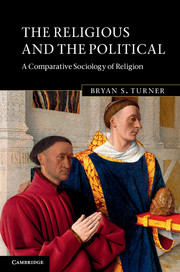Book contents
- Frontmatter
- Contents
- Acknowledgements
- Introduction
- Part I The religious and the political
- Part II State management of religion
- Part III Comparative and historical studies
- 8 Buddhism and the political: the sangha and the state
- 9 Confucianism as state ideology: China
- 10 Religion, state and Japanese exceptionalism: nihonjinron
- 11 State and Turkish secularism: the case of the Diyanet
- Part IV Conclusion
- References
- Index
10 - Religion, state and Japanese exceptionalism: nihonjinron
Published online by Cambridge University Press: 05 April 2013
- Frontmatter
- Contents
- Acknowledgements
- Introduction
- Part I The religious and the political
- Part II State management of religion
- Part III Comparative and historical studies
- 8 Buddhism and the political: the sangha and the state
- 9 Confucianism as state ideology: China
- 10 Religion, state and Japanese exceptionalism: nihonjinron
- 11 State and Turkish secularism: the case of the Diyanet
- Part IV Conclusion
- References
- Index
Summary
Introduction: Japanese uniqueness
In this volume I have deliberately and self-consciously referred to the work of Max Weber in virtually every chapter as a starting point from which to launch a study of politics and religion within a comparative perspective. In the case of Japan we cannot employ the same strategy, because he had little to say about Japanese society. However, he concluded The religion of China (1951: 248) with the observation that the ‘Chinese in all probability would be quite capable, probably more capable than the Japanese, of assimilating capitalism which has technically and economically been fully developed in the modern cultural area’. For Weber, China and Japan were different in one crucial respect. Whereas in China the literati had been the dominant status group, in the case of Japan he observed that the samurai had despised ‘the pen-pushers’ of the imperial bureaucracy (Weber, 1951: 120). Japan obviously presents a challenge to Weber’s views regarding the social conditions that contributed to the rise of capitalism, given the impressive success of Japan as an industrial society.
Weber commented on the organization of religion, specifically Buddhism, in Japan in The religion of India, and we might speculate therefore about what Weber might have written about Japan had he written The religion of Japan. First, there is a well-established tradition of folk religion in Japan that was local and closely related to agricultural production and seasons. Mountains have been an important part of Japanese religion and symbols of national specificity. Weber noted (1958: 281) that the religiosity of the ordinary people ‘approximated general Asiatic and ancient conditions insofar as Shinto, Confucian, Taoist and Buddhist deities and redeemers were called upon according to function and occasion’. Second, Buddhism was closely connected to the Japanese system of power, and noble families were interrelated to the hierarchy of monastic authority.
- Type
- Chapter
- Information
- The Religious and the PoliticalA Comparative Sociology of Religion, pp. 186 - 205Publisher: Cambridge University PressPrint publication year: 2013



